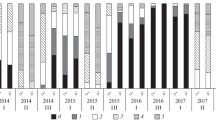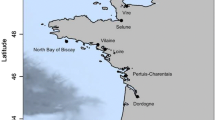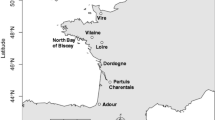Abstract
In spite of shrinking populations, the Allis shad (Alosa alosa Linnaeus, 1758) is a species of commercial importance in Europe. On the Iberian Peninsula, especially in the international Minho River, it also represents an important cultural heritage. From the mid-twentieth century on, a marked decrease in the number of spawners occurred in that river, following the reduction of available habitat due to dam construction. We investigated the biology and ecology of the Minho River’s Allis shad population, considering: spawners age structure and migration behaviour, reproductive biology, hybridization with Twaite shad (Alosa fallax Lacepède, 1803), juvenile growth, habitats and diet, as well as parasites. Results suggest that males migrated 1 year earlier than females and earlier in the season. Females’ gonadosomatic index increased with time and was higher within the spawning area. According to gill raker numbers, the level of hybridization is higher in juveniles than in adult samples (17 and 3.6 % respectively). To the best of our knowledge, we present the first report of the parasite Anisakis pegreffii in Allis shad, as well as other mouth and visceral cavity parasites. We also reported the first molecular confirmation of the parasite Rhadinorhynchus pristis to this species. Our results will be useful for future management and conservation of the studied population, which is one of the last stable European shad populations.





Similar content being viewed by others
References
Alexandrino P (1996) Estudo de populações de Sável (Alosa alosa L.) e Savelha (Alosa fallax Lacépéde). Análise da diferenciação interespecífica, subestruturação e hibridação. PhD thesis. Faculty of Sciences of University of Porto, Portugal
Alexandrino P, Boisneau P (2000) Diversité génétique. In: Baglinière JL, Elie P (eds) Les aloses (Alosa alosa et Alosa fallax spp.). Écobiologie et variabilité des populations. Inra-Cemagref, Paris, pp 179–196
Alexandrino P, Faria R, Linhares D, Castro F, Le Corre M, Sabatié R, Baglinière JL, Weiss S (2006) Interspecific differentiation and intraspecific substructure in two closely related clupeids with extensive hybridisation, Alosa alosa and Alosa fallax. J Fish Biol 69(B): 242–259
Allee WC (1931) Animal aggregations: a study in general sociology. University of Chigaco Press, Chicago
Antunes C, Weber M (1996) The glass eel fishery and the by-catch in the Rio Minho after one decade (1981–1982 and 1991–1992). Arch Pol Fish 2(a): 131–139
Aprahamian MW, Baglinière JL, Sabatié MR, Alexandrino P, Aprahamian CD (2002) Synopsis of biological data on Alosa alosa and Alosa fallax spp. R&D Technical Report W1-014. Environment Agency R&D Dissemination Center, WRc, Frankland Road, Swindon, Wilts. SN5 8YF
Aprahamian MW, Aprahamian CD, Baglinière JL, Sabatié R, Alexandrino P (2003) Alosa alosa and Alosa fallax spp.: literature review and bibliography. R&D Technical Report W1-014/TR. Environment Agency, Bristol
Assis CA, Almeida PR, Moreira F, Costa JL, Costa MJ (1992) Diet of the twaite shad Alosa fallax (Lacépède) (Clupeidae) in the River Tagus estuary, Portugal. J Fish Biol 41:1049–1050
Bagenal TB, Tesch FW (1978) Age and growth. In: Bagenal TB (ed) Methods for assessment of fish production in freshwaters. Blackwell Science Publication, Oxford, pp 101–136
Baglinière JL (2000) Le genre Alosa sp. In: Baglinière JL, Elie P (eds) Les aloses (Alosa alosa et Alosa fallax spp.). Écobiologie et variabilité des populations. Inra-Cemagref, Paris, pp 3–30
Baglinière JL, Boisneau C, Boisneau P (1988) Étude de la Grande Alose (Alosa alosa) dans le bassin de la Loire. Lab. Eco. Aquat., contrat INRA Rennes/Ministère de l’Environnement (SRETIE) CSP
Baglinière JL, Sabatié MR, Aprahamian MW, Alexandrino P, Aprahamian CD, Assis CA, Cassou-Leins JJ, Le Corre M, Mennesson-Boisneau C, Martin-Vandembulcke D, Rochard E, Teixeira C (2001) A guide to scale interpretation and age estimation for the east-Atlantic and west-Mediterranean Shads (Alosa spp.). Bull Fr Pêche Piscic 359:545–587
Baglinière JL, Sabatié MR, Rochard E, Alexandrino P, Aprahamian MW (2003) The Allis Shad Alosa alosa: biology, ecology, range, and status of populations. Am Fish Soc Symp 35:85–102
Baldaque da Silva AA (1892) Estado actual das pescas em Portugal. (Current status of fisheries in Portugal). Ministério da Marinha e Ultramar, Imprensa Nacional, Lisboa
Bao M, Garci ME, Antonio JM, Pascual S (2013) First report of Anisakis simplex (Nematoda, Anisakidae) in the sea lamprey (Petromyzon marinus). Food Control 33:81–86
Bardonnet A, Jatteau Ph (2008) Salinity tolerance in young Allis shad larvae (Alosa alosa L.). Ecol Freshw Fish 17:193–197
Barton E (1998) Eastern boundary of the North Atlantic: Northwest Africa and Iberia. In: Robinson A, Brink K (eds) The Sea Vol 11 the global coastal ocean. Wiley, pp 633–657
Bengen G, Kugler J, Pequignot J (1991) Etude des ovocytes d’ Alosa alosa (Clupeidae) au cours the sa migration anadrome en Garonne. Cybium 15(3):229–238
Boisneau P, Mennesson-Boisneau C, Guyomard R (1992) Electrophoretic identity between Allis Shad, Alosa alosa (L.) and Twaite Shad, A. fallax (Lacepede). J Fish Biol 40:731–738
Cabral MJ (Coord.), Almeida J, Ameida PR, Dellinger T, Ferrand de Almeida N, OLIVEIRA ME, Palmeirim JM, Queiroz AL, Rogado L, Santos-Reis M (eds) (2006) Red book of the Portuguese vertebrates, 2nd ed. Instituto da Conservação da Natureza Assírio & Alvim Lisboa
Cassou-Leins F, Cassou-Leins JJ (1990) Étude de la dévalaison des juveniles d’Alosa alosa L., au cours de la campagne 1990. ENSAT
Collares-Pereira MJ, Cowx IG, Sales Luís T, Pedrosa N, Santos-Reis M (1999) Observations on the ecology of a landlocked population of Allis shad in Aguieira Reservoir, Portugal. J Fish Biol 55:658–664
Costa MJ, Almeida PR, Domingos IM, Costa JL, Correia MJ, Chaves ML, Teixeira CM (2001) Present status of shads’ populations in Portugal. First Conference of European Shads, Bordeaux, France. Bull Fr Pêche Piscic pp 362–363
Costa G, Pontes T, Rego AA (2004) Prevalence, intensity and abundance of Rhadinorhynchus pristis (Acanthocephala, Rhadinorhynchidae) in chub mackerel, Scomber japonicus (Pisces, Scombridae) from Madeira Island. Acta Parasitologica 49:41–44
Costa G, Santos MJ, Costa L, Biscoito M, de Carvalho MAAP, Melo-Moreira E (2009) Helminth parasites from the stomach of Conger eel, Conger conger, from Madeiran Island, Atlantic Ocean. J Parasitol 95(4):1013–1015
Detlefsen H, Speth P (1980) Investigations on coastal upwelling off Northwest Africa and Portugal with empirical orthogonal functions. Deutsche Hydrografische Zeitschrift 33(5):210–221
Doadrio I (ed) (2002) Atlas y Libro Rojo de los Peces Continentales de España. Dirección General de Conservación de la Naturaleza/Museo Nacional de Ciencias Naturales-CSIC, Madrid
EFSA (European Food Safety Authority) (2010). Scientific opinion on risk assessment of parasites in fishery products. EFSA J 8(4):91. http://www.efsa.europa.eu/en/efsajournal/pub/1543.htm1543
Eiras JC (1977) Algumas medidas de protecção ao sável (Alosa alosa L.) do Rio Douro. Publicações do Instituto de Zoologia Dr. Augusto Nobre 124:11–16
Eiras JC (1981a) Contribuição para o conhecimento da biologia de Alosa alosa L. Estudo de algumas modificações somáticas, fisiológicas e bioquimicas durante a migração anádroma no Rio Douro. PhD thesis. Faculty of Sciences of University of Porto
Eiras JC (1981b) Sur une population d’Alosa alosa L., poisson migrateur amphibiotique, thalassotrophe, bloquée en eau douce au Portugal. Cybium 3(5):69–73
Eiras JC (1983) Some aspects on the biology of a landlocked population of anadromous shad Alosa alosa L. Publicações do Instituto de Zoologia Dr. Augusto Nobre 180:1–16
Faria R (2007) Estudo de Processos Evolutivos e Filogeografia em Espécies Europeias do Género Alosa. (Study of evolutionary processes and phylogeography in European species of the Genus Alosa). PhD thesis. Faculty of Sciences, University of Porto, Portugal
Faria R, Weiss S, Alexandrino P (2006) A molecular phylogenetic perspective on the evolutionary history of Alosa spp. (Clupeidae). Mol Phylogenet Evol 40:298–304
Faria R, Weiss S, Alexandrino P (2012) Comparative phylogeography and demographic history of European shads (Alosa alosa and A. fallax) inferred from mitochondrial DNA. BMC Evol Biol, pp 12–20
Fraley C, Raftery AE (2002) Model-based clustering, discriminant analysis, and density estimation. J Am Statistical Assoc 97:611–631
Fraley C, Raftery AE, Murphy TB, Scrucca L (2012) mclust Version 4 for R: normal mixture modeling for model-based clustering, classification, and density estimation. Technical Report No. 597, Department of Statistics, University of Washington
Freyhof J, Kottelat M (2008) Alosa alosa. In IUCN 2013. The IUCN red list of threatened species. Version 2013.1. http://www.iucnredlist.org/details/903/0. Downloaded on 09 September 2013
Froese R (2006) Cube law, condition factor and length-weight relationship: history, meta-analysis and recommendations. J Appl Ichthyol 22:241–253
Froese R, Pauly D (eds) (2013) FishBase. World Wide Web electronic publication. www.fishbase.org, version (04/2013)
Greene CW (1926) The physiology of spawning migration. Physiol Rev 6:201–241
Hillman RJ, Cowx IG, Harvey JP (2003) Monitoring the Allis and Twaite shad. Conserving Natura 2000 Rivers Monitoring Series No. 3. English Nature, Peterborough
Hollander M, Wolfe DA (1973) Nonparametric statistical methods. Wiley, New York
IUCN-France MNHM, SFI, ONEMA (2010) La Liste Rouge des Espèces Menacées en France. Chapitre Poissons d’eau douce de France métropolitaine. Paris
King JJ, Roche WK (2008) Aspects of anadromous Allis shad (Alosa alosa Linnaeus) and Twaite shad (Alosa fallax Lacépède) biology in four Irish Special Areas of Conservation (SACs): status, spawning indications and implications for conservation designation. Hydrobiologia 602:145–154
Lassalle G, Trancart T, Lambert P, Rochard E (2008) Latitudinal variations in age and size at maturity among allis shad Alosa alosa populations. J Fish Biol 73:1799–1809
Leguen I, Véron V, Sevellec C, Azam D, Sabatié R, Prunet P, Baglinière JL (2007) Development of hypoosmoregulatory ability in allis shad Alosa alosa. J Fish Biol 70:630–637
Lochet A (2006) Devalaison des juveniles et tactiques gagnantes chez la grande alose Alosa alosa et l’alose feinte Alosa fallax: Apports de la microchimie et de la microstructure des otoliths. PhD thesis, University of Bordeaux I
Lochet A, Jatteau P, Tomás J, Rochard E (2008) Retrospective approach to investigating the early life history of a diadromous fish: allis shad Alosa alosa (L.) in the Gironde–Garonne–Dordogne watershed. J Fish Biol 72:946–960
Lochet A, Boutry S, Rochard E (2009) Estuarine phase during seaward migration for allis shad Alosa alosa and twaite shad Alosa fallax future spawners. Ecol Freshw Fish 18:323–335
Maitland PS, Hatton-Ellis TW (2003) Ecology of the Allis and Twaite Shad. Conserving Natura 2000 Rivers Ecology Series Nº 3. English Nature, Peterborough
Maitland PS, Lyle AA (2005) Ecology of Allis Shad Alosa alosa and Twaite Shad Alosa fallax in the Solway Firth, Scotland. Hydrobiologia 534:205–221
Martin Vandembulcke D (1999) Dynamique de population de la grande alose (Alosa alosa, L. 1758) dans le bassin versant Gironde–Garonne–Dordogne (France): analyse et prévision par modélisation. PhD thesis, Ecole Nationale Polytechnique, Toulouse
Mattiucci S, Paoletti M, Borrini F, Palumbo M, Macarone Palmieri R, Gomez V, Casati A, Nascetti G (2011) First molecular identification of the zoonotic parasite Anisakis pegreffii (Nematoda: Anisakidae) in a paraffin-embedded granuloma taken from a case of human intestinal anisakiasis in Italy. BMC Infect Dis 11:82
Mennesson-Boisneau C, Aprahamian M, Sabatié M, Cassou-Leins J (2000a) Remontée migratoire des adultes. In: Baglinière J, Elie P (eds) Les aloses (Alosa alosa et Alosa fallax spp.). Écobiologie et variabilité des populations. Inra-Cemagref, Paris, pp 55–72
Mennesson-Boisneau C, Aprahamian M, Sabatié M, Cassou-Leins J (2000b). Caractéristiques des adultes. In: Baglinière J, Elie P (eds) Les aloses (Alosa alosa et Alosa fallax spp.). Écobiologie et variabilité des populations. Inra-Cemagref, Paris, pp 33–53
Mota M, Antunes C (2011) First report on the status of Allis shad (Alosa alosa) in the Minho River (Northwestern Iberian Peninsula). J Appl Ichthyol 27(3):56–59
Mota M, Antunes C (2012) A preliminary characterisation of the habitat use and feeding of Allis shad (Alosa alosa) juveniles in the Minho River tidal freshwater wetlands. Limnetica 31(1):165–172
Mota M, Antunes C, Rochard E (2015) Status of the diadromous fish of the Iberian Peninsula: past, present and trends. Limnetica (in press)
Nykjaer L, Van Camp L (1994) Seasonal and inter-annual variability of coastal upwelling along northwest Africa and Portugal from 1981 to 1991. J Geohys Res 99:14197–14208
Öktener A, Trilles JP (2004) Report on Cymothoids (Crustacea, Isopoda) collected from marine fish in Turkey. Acta Adriat 45(2):145–154
Öktener A, Trilles JP, Alaş A, Solak K (2009) Cymothoid (Crustacea, Isopoda) records on marine fishes (Teleostei and Chondrichthyes) from Turkey. Bull Eur Assn Fish P 29(2):51
Pope KL, Kruse CG (2001) Assessment of fish condition data. In: Guy C, Brown M (eds) Statistical analyses of freshwater fisheries data. American Fisheries Society Publication, North Bethesda, pp 51–56
Quignard JP, Douchement C (1991) Alosa alosa (Linnaeus, 1758). In: Hoestlandt H (ed) The freshwater fishes of Europe, vol. 2 Clupeidae, Anguillidae. Wiesbaden: Aula, pp. 89–126
R Development Core Team (2009) R: a language and environment for statistical computing. R Foundation for Statistical Computing, Vienna, Austria, ISBN 3-900051-07-0, http://www.R-project.org
Rochard E (2001) Migration anadrome estuarienne des géniteurs de grande Alose Alosa alosa, allure du phénomène et influence du rythme des marées. Bull Fr Pêche Piscic 362(363):853–867
Rougier T, Lambert P, Drouineau H, Girardin M, Castelnaud G, Carry L, Aprahamian M, Rivot E, Rochard E (2012) Collapse of allis shad, Alosa alosa, in the Gironde system (southwest France): environmental change, fishing mortality, or Allee effect? ICES J Mar Sci 69(10):1802–1811
Sabatié MR (1993) Recherches sur l’écologie et la biologie des aloses du Maroc (Alosa alosa Linné, 1758 et Alosa fallax Lacépède, 1803). Exploitation et taxinomie des populations atlantiques; bioécologie des aloses de l’oued Sebou. PhD Thesis. Université de Bretagne Occidentale, Brest
Sabatié MR, Baglinière JL (2001) Quelques Traits Bioécologiques Des Aloses Du Maroc; Un Patrimoine Culturel Et Socio-Économique Récemment Disparu. Bull Fr Pêche Piscic 362(363):903–917
Sabatié MR, Alexandrino P, Baglinière JL (1996) Comparaison des caractéristiques biologiques de la Grande Alose (Alosa alosa) dans l’oued Sebou (façade Nord-Atlantique du Maroc) et dans le fleuve Lima (Portugal). Cybium 20(3):59–73
Sabatié MR, Boisneau P, Alexandrino P (2000) Variabilité morphologique. In: Baglinière J, Elie P (eds) Les aloses (Alosa alosa et Alosa fallax spp.). Écobiologie et variabilité des populations. Inra-Cemagref, Paris, pp 137–178
Shields BA, Bird P, Liss WJ, Groves KL, Olson R, Rossignol PA (2002) The nematode Anisakis simplex in American shad (Alosa sapidissima) in two Oregon rivers. J Parasitol 88(5):1033–1035
Taverny C (1991) Contribution à la connaissance de la dynamique des populations d’aloses (Alosa alosa L. et Alosa fallax Lacépède), dans le système fluvio-estuarien de la Gironde: pêche, biologie et écologie. Étude particulière de la dévalaison et de l’impact des activités humaines. PhD thesis. Université. Bordeaux: Université de Bordeaux 1/CEMAGREF Bordeaux
Taverny C, Cassou-Leins JJ, Cassou-Leins F, Elie P (2000) De l’oeuf à l’adulte en mer. In: Baglinière J, Elie P (eds) Les aloses (Alosa alosa et Alosa fallax spp.). Écobiologie et variabilité des populations. Inra-Cemagref, Paris, pp 93–124
Tomás J, Augagneur S, Rochard E (2005) Discrimination of the natal origin of young of-the-year Allis shad (Alosa alosa) in the Garonne-Dordogne basin (south-west France) using otolith chemistry. Ecol Freshw Fish 14:185–190
Walters C, Kitchell JF (2001) Cultivation/depensation effects on juvenile survival and recruitment: implications for the theory of fishing. Can J Fish Aquat Sci 58:39–50
Wilzbach MA, Mather ME, Folt CL, Moore A, Naiman RJ, Youngson AF, Mcmenemy J (1998) Proactive responses to human impacts that balance development and Atlantic salmon (Salmo salar) conservation: an integrative model. Can J Fish Aquat Sci 55(1):288–302
Yılmaz S, Polat N (2011) Length-weight relationship and condition factor of pontic shad, Alosa immaculate (Pisces: Clupeidae) from the southern Black Sea. Res J Fish Hydrobiol 6(2):49–53
Acknowledgments
The authors especially wish to thank Eduardo Martins and Dr. Ronaldo Sousa for field assistance and the Minho River community of fishers for the supply of biological samples. The authors are grateful to several collaborators who contributed with laboratory assistance, especially Sandra Fernandes, Sofia Ribeiro, Ana Rita Carvalho, Andreia Rodrigues, Sara Agra, Artur Loureiro, Hélder Reis, Adriana Pereira and Lukas Fingolo. This study was funded by a PhD grant from the FCT (Portuguese Foundation for Science and Technology) supporting Micaela Mota (SFRH/BD/44892/2008). The research was partially supported by the European Regional Development Fund (ERDF) through the COMPETE—Operational Competitiveness Programme and national funds through FCT—Foundation for Science and Technology, under the project “PEst-C/MAR/LA0015/2013”.
Author information
Authors and Affiliations
Corresponding author
Rights and permissions
About this article
Cite this article
Mota, M., Bio, A., Bao, M. et al. New insights into biology and ecology of the Minho River Allis shad (Alosa alosa L.): contribution to the conservation of one of the last European shad populations. Rev Fish Biol Fisheries 25, 395–412 (2015). https://doi.org/10.1007/s11160-015-9383-0
Received:
Accepted:
Published:
Issue Date:
DOI: https://doi.org/10.1007/s11160-015-9383-0




